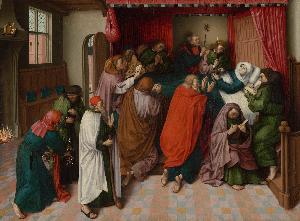Master Of The Almshouse Of The Seven Electors
Master Of The Almshouse Of The Seven Electors;Master Of The Amsterdam Death Of The Virgin
Place: Amsterdam Or Utrecht
Biography:
The Master Of The Almshouse Of The Seven Electors, also known as the Master of the Amsterdam Death of the Virgin, was a Netherlandish painter who flourished around 1500. His name is derived from a panel depiction of the Death of the Virgin, dated to about 1500 and now in the Rijksmuseum Amsterdam. The painting shows the Virgin Mary and the twelve Apostles in a complex interior, in intimate mood.
Artistic Style and Symbolism
The figures in the painting are small, with small heads and hands; their torsos, however, are bulky and covered in drapery. This unique style is characteristic of the Master Of The Almshouse Of The Seven Electors. The name "Master of the Almshouse of the Seven Electors" is sometimes preferred because it refers to the name of the institution that donated the painting to the museum. Key aspects of his work include:
- The use of small figures with bulky torsos and drapery
- The depiction of complex interiors and intimate moods
- The emphasis on symbolism, such as the lighted candle in The Death of the Virgin
Disagreements over Attribution and Origin
There is some disagreement over the attribution of paintings ascribed to the Master Of The Almshouse Of The Seven Electors. Some critics prefer instead to attribute some of them to the poorly known Master of the Lantern. Critics also disagree as to his origin; some have linked him to Amsterdam, while others have suggested ties to Utrecht and its school of manuscript painters. For more information on the Master Of The Almshouse Of The Seven Electors and his work, visit Wikioo.org or see the article on Wikipedia. The Rijksmuseum Amsterdam also has a collection of his work, including The Death of the Virgin, which can be viewed on their website. The Mauritshuis is another museum that houses an impressive collection of Dutch art and history, including works by famous artists such as Johannes Vermeer and Rembrandt van Rijn. For more information on the Mauritshuis and its collection, visit Wikioo.org. Note: All links are to Wikioo.org or Wikipedia.

